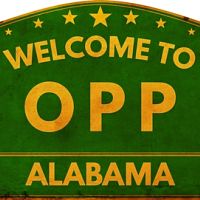
 |
|

|
COMPREHENSIVE EMERGENCY MANAGEMENT PLAN MIZELL MEMORIAL HOSPITAL 702 NORTH MAIN ST. P.O. BOX 1010 OPP, ALABAMA 36467 (334) 493-3541 INTRODUCTION The purpose of this plan is to provide a more formalized approach to emergency care during internal and external disasters and emergencies. Mizell Memorial Hospital is an acute care hospital with 99 licensed beds. The original building was constructed in 1949 with several additions and renovations thru the years. The hospital fronts on U.S. Highway 331, which is a major traffic artery for the Southern part of the state of Alabama. Highway 331 is also a designated Hurricane Escape Route for the Gulf Coast of Florida. The Mizell Memorial Hospital facilities are housed in a three story plus basement 108,000 square foot area. The hospital has 99 acute beds which includes a five-bed intensive care unit with state-of-the-art monitoring equipment. The facility also houses a 24-hour emergency department with a highly skilled medical and nursing staff, two operating rooms, a same day surgery unit, in-house CAT SCAN and Nuclear Medicine diagnostic. The administration and implementation of the plan rests with the Administrator of the hospital. In his absence, the Assistant Administrator/CFO, Assistant Administrator/Director of Quality, or the Assistant Administrator/Director of Nursing exercises this responsibility and serves as the alternate contact person. The name and telephone of these individuals are as follows.  Allen Foster, Administrator Allen Foster, AdministratorPhone: (334)493-9776  Jana Wyatt, Assistant Administrator/CFO Jana Wyatt, Assistant Administrator/CFOPhone: (334)493-0115  Debbie Franklin, Assistant Administrator/Director of Quality Debbie Franklin, Assistant Administrator/Director of QualityPhone: (334)493-2120  Pat Hill, Assistant Administrator/Director of Nursing Pat Hill, Assistant Administrator/Director of NursingPhone: (334) 493-9047 The plan defines policies, procedures, responsibilities and actions that the hospital will take in the event of severe and adverse weather conditions such as tornadoes and hurricanes and other emergencies that threaten the safety of patients, staff, visitors and the facility=s structure. The plan when implemented will achieve the following outcomes. 1. Availability of skilled/trained personnel who carry out pre-determined responsibilities before, during and after the occurrence of adverse weather conditions and other emergencies. 2. Coordinated and organized response to the adverse conditions at hand. 3. Maintenance of adequate staffing for the provision of essential care and services to patients/families. 4. Protection of lives, property and the environment. 5. Adequate capability for the reception and treatment of casualties and critically ill noncasualties if evacuation of the hospital is not necessary or after the adverse event has passed and the hospital is operational. 6. Enhanced coordination of response efforts with the Covington County Emergency Management office and other local, county and state agencies. 7. Organized evacuation process including the safe transport/relocation of patients with the adequate provision of food, water and other necessities. 8. Efficient management of supplies, communications, power, emergency equipment, security and record keeping. 9. Organized, efficient implementation of recovery operations as soon as the emergency/adverse conditions abates. AUTHORITY In order to identify the hierarchy of authority in place, an organizational chart is included in the plan (See Appendix). Also, each section of the plan identifies who is in charge and the chain of command that must be followed during any adverse condition or emergency. HAZARD ANALYSIS The hospital is vulnerable to hurricanes, tornadoes, flooding, fires, loss of utilities, medical gas loss (oxygen and nitrous oxide), hazardous materials incidents, and chemical incidents. The hospital is located on Hwy 331 - a major hurricane evacuation route. Railroad tracks run east and west of the hospital, approximately one mile south. The hospital is not located within 10 or 50 miles of a nuclear power plant. INFORMATION, TRAINING AND EXERCISE This section identifies the procedures for increasing employee and patient awareness of possible emergency situations and provide training on their roles before, during and after a disaster. A. How key workers are instructed in their emergency roles during non-emergency times Key workers and members of the administrative staff including the medical staff shall, as part of their job descriptions, accept the defined responsibilities and duties of their respective non-emergency roles during a declared disaster. During the orientation period for these individuals, they will review the hospital disaster plan and sign off their understanding of such. These plans shall be reviewed and by evidence of signatures, these same individuals shall review their roles annually. They will also participate in hospital=s semi-annual disaster exercise. B. Training of New Employees, Training Schedule for all employees and who provides training All new employees are trained in their roles during, before and after a disaster/emergency condition by attending the hospital orientation which occurs monthly. A schedule of dates and times is issued annually to all department managers. Thereafter each employee attends annual review day. C. Schedule for exercising all or portions of the disaster plan on a semi-annual basis. A scheduled disaster exercise is not conducive to appropriate testing of the hospital resources and capabilities. Mizell Memorial Hospital agrees to two exercises per year involving the hospital the regional EMS and other local agencies. An actual event may be used as one exercise during the year. D. Procedures for correcting deficiencies noted during training exercises. After any planned disaster exercise, a debriefing meeting of all agencies involved shall be conducted at Mizell Memorial Hospital to identify the deficiencies and opportunities for improvement noted during the testing of the facility. These deficiencies and opportunities for improvement shall then be addressed by the respective departments and necessary changes are incorporated in the plan. The hospital=s Safety Committee oversees the review of the opportunities for improvement and changes made to the plan. |
|
|||||||||||||||||||||
| Mizell Memorial Hospital, 702 Main Street, Opp, Alabama, 36467, (334) 493-3541 | |||||||||||||||||||||||
| ©2025 FastHealth Corporation Terms Privacy | US Patent Numbers 7,720,998 B2, 7,836,207 |